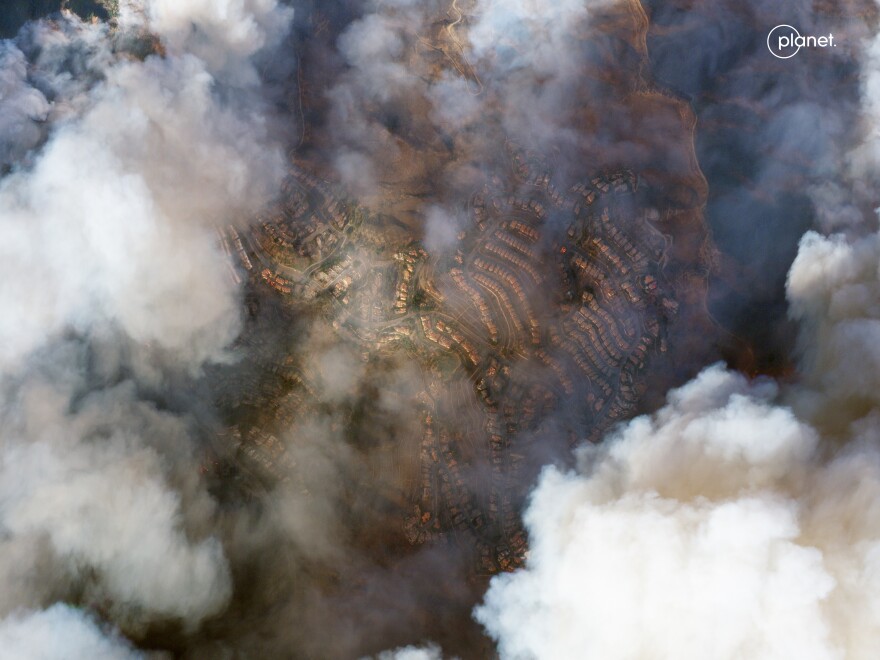Truth matters. Community matters. Your support makes both possible. LAist is one of the few places where news remains independent and free from political and corporate influence. Stand up for truth and for LAist. Make your year-end tax-deductible gift now.
Fact check: Could brush clearance have prevented the Palisades Fire?

As the destructive reality of the fires tearing through the greater Los Angeles area sets in, people are searching for answers about how things got so bad.
We’ve already fact checked what we know about the lack of water availability, but there have also been questions about whether enough brush prep was done in the Santa Monica Mountains ahead of the Palisades Fire. As of Friday, that fire has burned more than 21,000 acres and killed six people.
Former L.A. mayoral candidate and billionaire businessman Rick Caruso has suggested that brush clearance would have “significantly mitigated” the destruction and losses.
“The brush clearance alone, had that happened, would have just changed the trajectory of this fire,” Caruso said during an appearance on ABC 7 earlier this week.

However, that seems unlikely.
How it started
The Palisades Fire started at about 10:20 a.m. Tuesday, near Temescal Ridge Trail in the Santa Monica Mountains National Recreation Area.
At first, it was native chaparral in the surrounding hills that burned. But the fire quickly grew to 200 acres in just 12 minutes, driven by 80 mph winds, pushing into nearby neighborhoods.
What the experts say
“The bottom line is the winds far outweigh the fuel in terms of fire spread in a situation like this,” said Jon Keeley, fire ecologist with the U.S. Geological Survey. “When you have these winds it makes fuels less relevant. And the fuels are definitely not relevant once it gets into the urban environment, because the primary fuels are the homes.”
Here’s how UCLA climate scientist Daniel Swain put it:
"There is a set of weather and climate conditions that are so extreme under which there's not a whole lot that even very well prepared places can do to manage the most extreme wildfire events,” Swain said. “We're seeing the limits of what technology and preparedness can actually achieve in conditions like this."
A dangerous mix
The upshot: Short of denuding miles of the Santa Monica Mountains, there’s no guarantee that cutting back brush near to neighborhoods would've prevented some sort of vegetation from catching on fire and spreading. Powerful winds can throw embers more than a mile away, starting up new fires all over. It was the exact sort of conditions that we see during wind-driven fires here in Southern California that can make containing blazes all but impossible.
Look at satellite imagery and street view photographs of the neighborhoods just a few thousand feet away from where the fire started, and you can see an environment that had plenty of fuel for those embers to take off: streets lined with palm trees and homes surrounded by verdant landscaping. The types of features we've seen burn in plenty of other conflagrations.
Where brush treatment might have helped
Brush treatment around the community could have potentially helped provide defensible space for firefighters, giving them a bit of extra time to respond. Though, it's unclear if that would've been enough given the historically strong gusts.
For those wondering about prescribed or controlled burns, often used to lessen fuel load in an area, the practice isn't performed in the Santa Monica Mountains National Recreation Area. That's in part because native plants can have a hard time recovering, which causes its own set of problems.
And there's no guarantee that it'll lessen fire risk in chaparral habitats for an extended period of time.
Primed for a nightmare
As we've talked and written about before here at LAist, the Santa Monica Mountains were primed for a nightmare fire.
At this point in time, based on what we know so far, it appears this fire just took off in the wrong place at the wrong time.
If you want to prepare for the next big blaze, give our podcast The Big Burn a listen.
_











